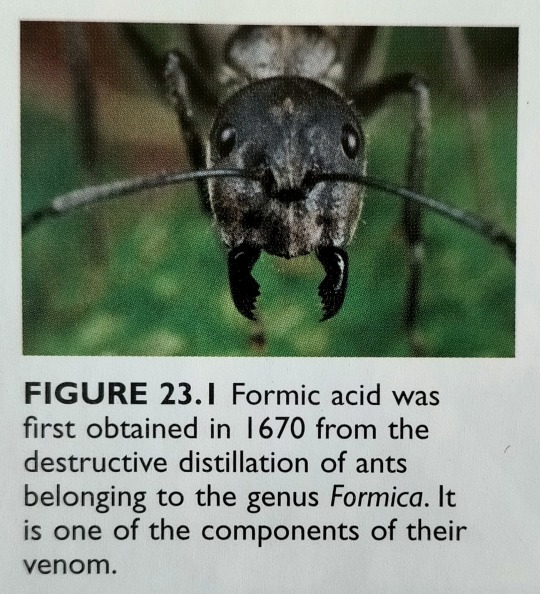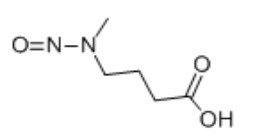#butanoic acid
Text
Table 23.1 lists several of the unbranched aliphatic carboxylic acids found in the biological world (e.g. figure 23.1), along with the common names of each.


"Chemistry" 2e - Blackman, A., Bottle, S., Schmid, S., Mocerino, M., Wille, U.
#book quotes#chemistry#nonfiction#textbook#aliphatic#carboxylic acid#70s#1670s#17th century#formica#ants#venom#formic acid#acetic acid#propionic acid#butyric acid#valeric acid#caproic acid#caprylic acid#capric acid#lauric acid#myristic acid#palmitic acid#stearic acid#arachidic acid#methanoic acid#ethanoic acid#propanoic acid#butanoic acid#pentanoic acid
4 notes
·
View notes
Text
The first four aliphatic carboxylic acids (formic, acetic, propanoic and butanoic acids) are infinitely soluble in water because the hydrophilic character of the carboxyl group more than compensates for the hydrophobic character of the hydrocarbon chain.
"Chemistry" 2e - Blackman, A., Bottle, S., Schmid, S., Mocerino, M., Wille, U.
#book quote#chemistry#nonfiction#textbook#carboxylic acid#formic acid#acetic acid#propanoic acid#butanoic acid#solubility#hydrophilic#carboxyl#compensation#hydrophobic#hydrocarbons
0 notes
Text
not heidenheim pouring butanoic acid where the leipzig fans stand so it smells like vomit for them
1 note
·
View note
Text
Unveiling the Potential of BMK Ethyl Glycidate: Understanding its Chemical Structure and Versatile Applications
BMK Ethyl Glycidate, a compound known for its versatility, has attracted significant attention across various industries due to its distinct properties and wide-ranging applications. This article provides a comprehensive exploration of BMK Ethyl Glycidate's chemical composition, synthesis methods, and its extensive uses in pharmaceuticals, fragrances, and beyond. Additionally, it delves into regulatory considerations surrounding its usage and discusses potential future prospects.
Introduction: BMK Ethyl Glycidate, also referred to as ethyl 3-oxo-4-phenylbutanoate, is a notable chemical compound derived from glycidic acid and ethyl alcohol. With its characteristic fruity scent and molecular formula C12H14O5, BMK Ethyl Glycidate has emerged as a prominent player in various industries due to its diverse applications and favorable chemical properties.
Chemical Composition: The synthesis of BMK Ethyl Glycidate involves esterification, where glycidic acid reacts with ethanol under acidic conditions, leading to the formation of an ester linkage. This results in the molecular structure of BMK Ethyl Glycidate, comprising a phenyl group attached to a butanoate backbone, with an oxo group positioned at the third carbon atom.
Synthesis Methods: Numerous methods exist for synthesizing BMK Ethyl Glycidate, each employing different reaction conditions and catalysts. Common methods include refluxing glycidic acid and ethanol with a strong acid catalyst like sulfuric acid or hydrochloric acid. Alternatively, transesterification reactions using ethyl acetate as a starting material have also been employed for BMK Ethyl Glycidate synthesis.
Applications: In the pharmaceutical sector, BMK Ethyl Glycidate serves as a crucial precursor for synthesizing various pharmaceutical compounds, including benzyl methyl ketone (BMK), which is an important intermediate in the production of pharmaceuticals such as amphetamines and other psychoactive substances. Additionally, its fruity aroma makes it a desirable ingredient in perfumes and flavoring agents within the fragrance industry.
Regulatory Considerations: Due to its association with the synthesis of controlled substances, particularly amphetamines, BMK Ethyl Glycidate is subject to stringent regulatory controls in many jurisdictions. Authorities closely monitor its production, distribution, and sale to prevent illicit use in drug manufacturing. Compliance with regulatory requirements is essential for companies involved in the production and distribution of BMK Ethyl Glycidate to ensure legal and ethical practices.
Future Perspectives: Despite regulatory challenges, the demand for BMK Ethyl Glycidate is expected to remain robust due to its indispensable role in pharmaceutical and fragrance industries. Ongoing research efforts aim to develop more efficient synthesis methods, explore novel applications, and address regulatory concerns to ensure responsible use and foster continued innovation.
Conclusion: In conclusion, BMK Ethyl Glycidate emerges as a versatile compound with diverse applications spanning pharmaceuticals, fragrances, and various other sectors. A thorough understanding of its chemical structure, synthesis methods, applications, and regulatory considerations is essential for researchers, industry professionals, and regulatory authorities alike. Continued exploration of BMK Ethyl Glycidate's properties and applications holds promise for further advancements while upholding ethical and regulatory standards.
0 notes
Text
Unlocking the Potential of BMK Ethyl Glycidate: Chemistry and Versatility Explored
This article delves into the distinctive characteristics of BMK ethyl glycidate, investigating its unique chemical composition and broad applications. The synthesis process, structural intricacies, and potential uses are scrutinized, fostering further research and development in this intriguing compound.
Introduction:
BMK ethyl glycidate, also known as ethyl 3-oxo-4-phenylbutanoate, falls within the glycidate esters category, showcasing its versatility through a distinct molecular structure. Synthesized from BMK glycidic acid and ethyl alcohol, its specific properties make it a compelling subject for exploration.
Chemical Composition and Structure:
Derived from BMK glycidic acid, the chemical structure of BMK ethyl glycidate significantly influences its physical and chemical characteristics. The combination of a phenyl group and butanoate ester enhances its potential applications.
Synthesis Methods:
Efficient synthesis methods are imperative for maintaining purity and achieving high yields. Typically, BMK ethyl glycidate is produced through the reaction of BMK glycidic acid with ethyl alcohol, utilizing specific catalysts and conditions.
Applications:
BMK ethyl glycidate finds utility across various sectors:
Perfume and Fragrance Industry: Valued for its enchanting aroma, it elevates fragrance formulations.
Pharmaceutical Industry: Plays a pivotal role as an intermediate in the synthesis of pharmaceutical compounds.
Flavoring Agents: Applied in the food and beverage industry for its flavor-enhancing properties.
Research and Development: Continuous exploration for additional applications based on its unique properties.
Conclusion:
BMK ethyl glycidate's distinctive chemical composition and versatile applications make it a captivating subject for ongoing research and development. Its potential uses in perfumery, pharmaceuticals, flavoring, and beyond underscore its significance across diverse industrial sectors. Ongoing investigation will deepen our understanding of this compound and its evolving role in various industries.
0 notes
Text
Butanoic Acid Manufacturing Plant Setup
Butanoic acid, also known as butyric acid, is a carboxylic acid with a four-carbon chain. It is a colorless liquid with a pungent odor and occurs naturally in various animal fats and dairy products, contributing to their distinct flavors and aromas.
Read Full Report : https://www.imarcgroup.com/butanoic-acid-manufacturing-plant-project-report
0 notes
Text
0 notes
Text
Impurity N-Nitroso-N-methyl-4-aminobutyric Acid
Impurity N-Nitroso-N-methyl-4-aminobutyric Acid
We supply API impurities,Metabolites. D-Label Compound, working Reference Standard,Isopar L,isopar G, C-Phycocyanin and other Specialty Chemicals.
N- Nitrosoamine Butyric Acid

​N-Nitroso-N methyl-4-aminobutyric Acid
Synonyms :- N- Nitrosoamine Butyric Acid, N-Nitroso-N-Methylamino Butyric Acid, 4-(Methylnitrosoamino)butanoic Acid, NMBA, NMABA
Chemical Name :- N-Methyl-N-(3-carboxypropyl)nitrosamine
CAS No :- 61445-55-4
Molecular Formula:- C5H10N2O3
Molecular Weight:- 146.15
N-Methyl-N-(3-carboxypropyl)nitrosamine
Address :- FF-4, Limbani Complex, Nr. Gormoh Hotel, Iscon-Bopal Road, Ambli, Ahmedabad - 380058. Gujarat. India
Call us :- +91 9227808809, +91 8866555288
Email :- [email protected]
Website :- saitraders.co.in
0 notes
Text
Butyric Acid Market - Forecast (2023 - 2028)
Butyric acid market size is forecast to reach US$436.2 million by 2026, after growing at a CAGR of 12.1% during 2021-2026. Butyric acid is a carboxylic acid, also known as butanoic acid. The product has an acrid taste and is usually found in the milk of farm animals such as goats, cows, buffalo, and sheep. The rising demand for specialty chemicals in various end-use industries such as pharmaceutical, animal feed, and food & beverage, and personal care industries are driving the market growth during the forecast period. Starch is a tasteless powder that is easily insoluble in cold water, alcohol, or other solvents. The high prevalence of health-related issues such as diabetes, anxiety, obesity, and others are also supporting the market growth for butyric acid. The growing poultry industry along with the growing consumption of chicken globally is propelling the market demand. The growing demand for alternative and biofuels in the automotive and aerospace industries is one of the major driving factors for butyric acid. The changing lifestyle, rise in working women in developing nations leads to more usage of cosmetics which is further driving the market growth between 2021-2026. However, fluctuating raw material prices and health hazards associated with butyric acid are likely to hamper the market growth during the forecast period.
Request Sample : https://tinyurl.com/93ebzpd9
#Butyric Acid Market price#Butyric Acid Market size#Butyric Acid Market share#Butyric Acid Market forecast#Butyric Acid Market trends
0 notes
Text
Butyrate Supplement for Colon Health - Professional Supplement Review | National Nutrition Canada
youtube
Karlene gives us a 3-minute professional supplement review on Butyrate, a short chain fatty acid that has been found to help support the digestive tract and reduce inflammation in the body.
To learn more about Butyrate and how to supplement with it, click here: https://www.nationalnutrition.ca/articles/supplements/butyrate/
Butyric acid (butanoic acid) is a Short Chain Fatty Acid found naturally in the human digestive tract. It is produced from the breakdown of dietary fiber in the colon in the presence of beneficial bacteria. Butyrate has been found to help reduce inflammation in the colon and may help to stop cancer and prevent memory loss in Alzheimer’s disease...
Visit - https://www.nationalnutrition.ca/
0 notes
Text
For example, consider the four compounds listed in table 20.1, all of which have different molecular formulae but the same nominal molecular mass.

"Chemistry" 2e - Blackman, A., Bottle, S., Schmid, S., Mocerino, M., Wille, U.
#book quotes#chemistry#nonfiction#textbook#comparison#butanoic acid#butane diamine#pentanol#n n dimethylurea
2 notes
·
View notes
Link
0 notes
Text
Good bacteria in the gut breakdown dietary fiber to produce butyric acid, a fatty acid

Butyric acid, along with acetic acid and propionic acid, is one of the three most prevalent short-chain fatty acids (SCFAs) in the gut. About 90–95% of the SCFAs in the gut, which are created when gut-friendly bacteria breakdown dietary fibre, are made up of these saturated fatty acids. It is well known that butyric acid supports healthy digestion, lowers inflammation, lowers the risk of disease, and improves general health. It plays a critical role in giving colon cells the energy they require to perform their typical functions and also controls blood sugar and cholesterol levels. Other names for it include Butyric Acid and butanoic acid.
The colon cells that make up the lining of the intestine are primarily powered by butyric acid. The colon cells that line the gut primarily use butyrate as an energy source, whereas the majority of body cells primarily use glucose. Without butyrate, these cells cannot function normally. The short-chain fatty acids provide an oxygen-free environment for the development of gut microbes that regulate inflammation and maintain the health of gut cells.
Read More @ https://delightblogging.blogspot.com/2022/08/butyric-acid-is-fatty-acid-thats-made.html
0 notes
Link
0 notes
Text
Unveiling the Potential of BMK Ethyl Glycidate: A Concise Overview
BMK ethyl glycidate, renowned for its versatility, is garnering attention for its unique properties and wide-ranging applications. This article provides a brief exploration of its chemical composition, synthesis methods, and diverse uses across industries, from fragrance manufacturing to pharmaceuticals.
Introduction: BMK ethyl glycidate, also known as ethyl 3-oxo-4-phenylbutanoate, holds promise due to its intriguing characteristics and practical applications. This concise overview aims to shed light on its chemical structure, synthesis routes, and multifaceted roles in various sectors.
Chemical Composition and Synthesis: The synthesis of BMK ethyl glycidate involves esterification of BMK oil and ethyl alcohol, typically catalyzed by acids. With a molecular formula of C12H14O5, its reactivity arises from a butanoate group attached to a phenyl ring.
Applications:
Fragrance Industry: BMK ethyl glycidate imparts a sweet, fruity aroma to perfumes and scented products.
Pharmaceuticals: It serves as a crucial intermediate in synthesizing pharmaceutical compounds like anticoagulants and anti-inflammatory drugs.
Food Additives: Used for flavoring confectionery and beverages, thanks to its appealing aroma and taste.
Research and Development: Valuable for chemical research, enabling the creation of new compounds and exploration of reactions.
Future Perspectives: Continued research into sustainable synthesis methods and eco-friendly production processes promises responsible use of BMK ethyl glycidate in the future.
Conclusion: BMK ethyl glycidate emerges as a compound with immense potential across industries. Ongoing research efforts are poised to uncover further opportunities for its application and advancement.
0 notes
Text
The homopolymer formed from 4 - hydroxy- butanoic acid is
The homopolymer formed from 4 – hydroxy- butanoic acid is
Ans. d

View On WordPress
0 notes